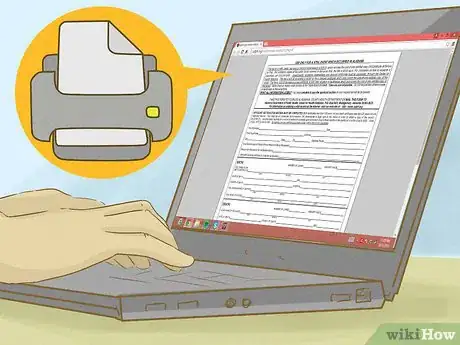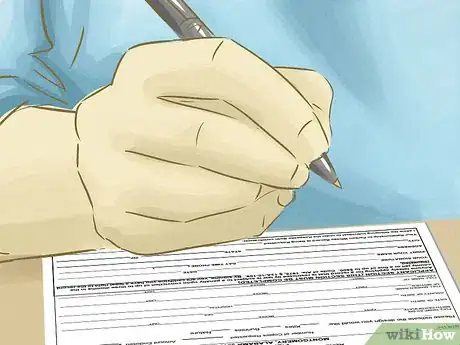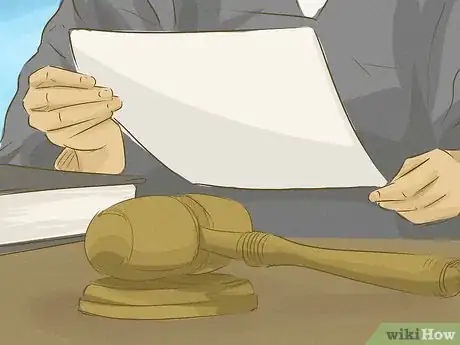This article was written by Jennifer Mueller, JD. Jennifer Mueller is an in-house legal expert at wikiHow. Jennifer reviews, fact-checks, and evaluates wikiHow's legal content to ensure thoroughness and accuracy. She received her JD from Indiana University Maurer School of Law in 2006.
There are 11 references cited in this article, which can be found at the bottom of the page.
This article has been viewed 56,956 times.
Typically, you can't sue the federal government. However, the Federal Tort Claims Act (FTCA) provides a limited right for private citizens to file a lawsuit in federal court against a federal government agency for negligence or personal injury claims. You may have a lawsuit under the FTCA if, for example, you were hit by a postal service truck while crossing the street, or you slipped and fell in a Social Security office. A lawsuit under the FTCA is more complicated than a basic personal injury lawsuit against another individual or a private business, and you must first exhaust administrative remedies before you have the right to sue the federal government.[1]
Steps
Filing an Administrative Claim
-
1Confirm that the FTCA permits your claim. While the FTCA provides monetary compensation for any physical injury or property loss or damage caused by the negligence of federal government employees, there are significant limitations and exceptions.[2]
- For example, only federal employees can be sued under the FTCA – not independent contractors. This means you may have to find out the employment relationship of anyone you believe was responsible for your injury or property damage.
- Your claim also must be based on the laws in the state where the incident took place. In other words, your claim must be rooted in a state law that would allow you to recover damages if you had been injured by a private individual.
- Generally, you must base your claim in negligence law, rather in alleging the employee acted intentionally. To prove a negligence claim, you must show that the person had a duty of care to prevent the injury or damage, and that he or she failed to carry out that duty, and that you were injured as a result.
- If you have any questions or aren't sure if your claim qualifies under the FTCA, you might consider consulting an attorney. Most personal injury attorneys who specialize in the FTCA also give free initial consultations, which you can use to get the attorney's assessment of whether you have a claim.
-
2Download the standard claim form. The FTCA requires claimants to "exhaust administrative remedies" before filing a lawsuit in federal court, which you can do by using the federal government's claim form. This form is acceptable by all federal government agencies.[3] [4]
- Standard Form 95 is not required to file a claim under the FTCA, but using it ensures your claim contains all the information the agency requires to process your claim.
- You can download the fillable form at https://www.justice.gov/sites/default/files/civil/legacy/2011/11/01/SF-95.pdf.
- Your claim must be filed with the agency within two years of the date the incident occurred that caused your injury or property damage.
- You also can request a paper copy of the form at any federal government agency.
Advertisement -
3Complete your form. In addition to information about you and the federal government agency you believe is responsible for your injuries, you must include facts about the incident and calculate the total amount of damages you believe you are owed.[5] [6]
- Include as many specific details as possible about the incident that led to your injuries or property damage. If there were any witnesses to the incident, include their names and contact information.
- Your damages must be an exact dollar amount – not a range or an estimate. You must attach documents to your claim form as evidence of the amount of damages.
- For example, if you were injured, you must attach a written report from a doctor regarding the nature and extent of your injury and treatment, as well as any bills or other statements of expenses you actually incurred as a result of the injury.
- If your claim relates to personal property that was damaged or destroyed, you must include at least two competent valuations and damage estimates made by people with experience providing estimates about that type of property who are unrelated to you or your claim, such as mechanics if you are alleging damage to your vehicle.
-
4Submit your claim to the appropriate agency. Once you've completed your form, sign it and make a copy for your records before submitting it to the agency you believe is responsible for your damages.[7] [8]
- Typically, your claim will be submitted to the agency's office of general counsel through the chief counsel in the geographic area where the incident took place that led to your claim.
- You may be able to find information about where to file your claim on the agency's website, or you can call the nearest office of the agency with which you want to file your claim and ask.
-
5Wait for a response. Once you've submitted your claim, the agency has six months to rule on your claim and determine whether you are entitled to some or all of the money damages you demanded on your form.[9]
- Once the agency receives your claim, it will evaluate the claim itself and investigate the incident and the circumstances surrounding your claim. The exact procedure of investigation varies depending on the agency.
- Based on its investigation, the agency may reject your claim. If it rejects your claim or does not respond within six months, you are free to file a lawsuit in federal court.
- The agency also may choose to "admit" your claim, meaning your claim is accepted and the agency offers you a settlement. This settlement may cover some or all of the amount to which you claimed you were entitled.
- You may accept or reject this settlement. If you accept it, the agency will issue you a check and your claim will be resolved. If you reject the settlement, you may choose to file a lawsuit or to appeal the settlement offer within the agency.
- If you decide to file a lawsuit, it must be filed within six months after the final disposition from the agency. If you filed an appeal, this six-month period doesn't start running until after your appeal has been considered.
Filing a Lawsuit
-
1Hire an attorney. If you are dissatisfied with the outcome of your administrative claim, you have the right to sue the federal agency in federal court. Due to the complexity of the FTCA as well as federal court procedure, hiring an attorney is the best ways to protect your interests and maximize your recovery.[10] [11]
- The best place to begin your search for an attorney is the searchable directory on the American Bar Association's website.
- Look for an attorney or law firm specializing in FTCA claims. The FTCA is a fairly complex federal law with many defenses, exceptions, and limitations, so it's important that your attorney be well-versed in the law and have experience litigating FTCA cases in particular, not just personal injury cases generally.
- Personal injury attorneys, including those who specialize in FTCA claims, typically work on contingency, which means they take a percentage of any settlement or award you receive rather than charging you fees and costs up front.
-
2Draft your complaint. Your complaint is the document that will initiate your lawsuit, and provides the court with information about your claim, including the facts you allege constitute negligence on the part of a government employee, and caused you personal injury or property loss.[12] [13]
- In addition to identifying specifically the person responsible for your injuries or property damage and the federal agency for which he or she works, your complaint must specify when your administrative claim was filed and the outcome of that claim.
- However, the defendant you list in your complaint will be the United States, and only the United States. You are not filing a lawsuit against the individual government employee whose negligence caused your injury or property damage.
- Your attorney will need copies of any documents you received in response to your claim to attach to your complaint. If you cannot prove that you have fully exhausted administrative remedies before filing your lawsuit, your lawsuit will be dismissed.
- The bulk of your complaint consists of a list of facts that together constitute negligence for which the state law entitles you to receive damages from the defendant.
- Your attorney typically will go over the complaint before he or she files it and make sure all the information it contains is accurate and true to the best of your knowledge. If there's anything in the complaint that you don't understand, ask your attorney to explain it to you.
-
3File your complaint. To sue the federal government, you must take your complaint to the court of the federal district court nearest the federal government agency where the incident took place that caused your injuries or property damage.[14] [15]
- A federal complaint can be filed in person at the clerk's office or electronically. Your attorney probably will use electronic filing.
- All complaints must be accompanied by a filing fee of $400. Your attorney will pay this fee and add it to the costs of the lawsuit, which will be deducted from any settlement or award you receive.
- However, keep in mind you may have to pay this fee if you don't win your case or aren't offered an agreeable settlement.
- When you file your complaint, the clerk will assign your case to a judge at random and issue a case number, which must be used in all other documents filed with the court in your case.
-
4Have the federal government served. After you've filed your complaint, you must have it delivered to the federal government entities listed in the federal court rules.[16] [17]
- In federal courts, lawsuits can be served either by having a U.S. Marshal hand-deliver the complaint and summons to the defendant or by having the documents mailed using certified mail with returned receipt requested.
- The federal court rules give you 120 days to complete service from the date your complaint is filed. If you fail to complete service by this deadline, your case could be dismissed.
- Generally, you must serve the U.S. attorney for the district where your case was filed, and to the civil-process clerk at the U.S. attorney's office. You also may have to serve the agency and the employee whose negligence caused your injury or property damage.
- Once service is complete, a proof of service form must be filled out and filed with the court.
Heading to Court
-
1Receive the agency's answer. From the date the agency is served with your complaint, it has 60 days to respond by filing an answer or other response such as a motion to dismiss.[18] [19]
- If no answer is filed, you may be eligible to win your case by default. However, don't expect the federal government not to respond to your lawsuit.
- Typically, the government's answer will consist mostly of denials of your allegations. The government also may include a motion to dismiss. In this situation, you typically must attend a hearing along with your attorney to defend the legitimacy of your claim.
- After the government has responded, the judge may call all parties to participate in a conference to discuss the timeframe for litigation and create a schedule for various phases of litigation, such as written discovery, to be completed.
-
2Discuss any settlement offer. After you've filed your lawsuit, your case will be assigned to a team of attorneys from the U.S. Department of Justice, who may offer a settlement that varies significantly from the outcome of your administrative claim.[20]
- Your attorney must let you know of any settlements that are offered. He or she may give you advice concerning whether you should accept the settlement offered, but the ultimate decision is yours.
- If you choose not to accept a settlement, litigation will continue. On the other hand, accepting a settlement will end the lawsuit.
- The government typically will provide a written settlement agreement for you to sign, and give the settlement check to your attorney. Your attorney will take the costs of the lawsuit and his or her fees off the top, then give you a check for the rest.
-
3Conduct discovery. If you are unable to reach a settlement, the next phase of pretrial litigation begins. Through the discovery process, you and the federal agency exchange information and evidence regarding your claim and the facts you allege.[21]
- Written discovery includes interrogatories, which are questions asked by one party that the other party must answer under oath, and requests for production of documents, which require the party receiving the requests to provide to the other documents and other evidence relevant to the case in response.
- Discovery may also include depositions, which are live interviews of parties or witnesses to the incident that caused your injury or property damage. These interviews are recorded by a court reporter, who creates a transcript of the proceedings.
- For example, you may want to depose anyone present at the incident in which you were injured or your property was damaged. You also probably will depose the employee whose negligence you believe caused your injury or property damage, and his or her supervisors.
-
4Attempt mediation. Although some district courts require civil litigants to at least attempt mediation before a trial is scheduled, you should consider taking advantage of this service even if the courts don't require it.[22]
- Mediation provides a non-confrontational environment in which a neutral third party will facilitate a conversation between you and the government aimed at finding common ground and achieving a mutually agreeable resolution of some, if not all, aspects of your claim.
- Some districts have their own mediation programs, while in others you will have to find a suitable mediator on your own. Your attorney typically will work with the government attorneys to choose a mediation service if both parties agree to use mediation.
- Keep in mind that mediation is a voluntary process, and you aren't required to come to a settlement. However, if you do reach a settlement, signing a written settlement agreement will make it legally binding.
- If you are unable to reach a settlement through mediation, your attorney will work closely with you to prepare evidence and witnesses for trial.
References
- ↑ http://www.nolo.com/legal-encyclopedia/suing-government-negligence-FTCA-29705.html
- ↑ http://www.nolo.com/legal-encyclopedia/suing-government-negligence-FTCA-29705.html
- ↑ http://www.nolo.com/legal-encyclopedia/suing-government-negligence-FTCA-29705.html
- ↑ https://www.justice.gov/civil/documents-and-forms-0
- ↑ http://www.nolo.com/legal-encyclopedia/suing-government-negligence-FTCA-29705.html
- ↑ https://www.justice.gov/sites/default/files/civil/legacy/2011/11/01/SF-95.pdf
- ↑ http://www.nolo.com/legal-encyclopedia/suing-government-negligence-FTCA-29705.html
- ↑ http://www.va.gov/OGC/FTCA.asp
- ↑ http://www.nolo.com/legal-encyclopedia/suing-government-negligence-FTCA-29705.html
- ↑ http://www.nolo.com/legal-encyclopedia/suing-government-negligence-FTCA-29705-2.html
- ↑ http://www.leesfield.com/sue-the-government-for-negligence.html
- ↑ http://www.wawd.uscourts.gov/sites/wawd/files/ProSeManual4_8_2013wforms.pdf
- ↑ http://finchmccranie.com/the-federal-tort-claims-act/
- ↑ http://www.wawd.uscourts.gov/sites/wawd/files/ProSeManual4_8_2013wforms.pdf
- ↑ http://www.americanbar.org/groups/public_education/resources/law_issues_for_consumers/lawyerfees_contingent.html
- ↑ http://www.wawd.uscourts.gov/sites/wawd/files/ProSeManual4_8_2013wforms.pdf
- ↑ https://www.law.cornell.edu/rules/frcp/rule_4
- ↑ http://www.wawd.uscourts.gov/sites/wawd/files/ProSeManual4_8_2013wforms.pdf
- ↑ http://finchmccranie.com/the-federal-tort-claims-act/
- ↑ http://www.nolo.com/legal-encyclopedia/suing-government-negligence-FTCA-29705-2.html
- ↑ http://www.wawd.uscourts.gov/sites/wawd/files/ProSeManual4_8_2013wforms.pdf
- ↑ http://www.sidley.com/~/media/files/publications/2009/01/dispute-resolution-and-the-vanishing-trial-compa__/files/view-article/fileattachment/govlitadroutcomes.pdf
About This Article
Although you typically can’t sue the federal government, you can sue a federal government agency for negligence or personal injury. Before you can sue an agency in court, you’re required to first file an administrative claim. You can do this by downloading the standard claim form from the FTCA website and submitting it to the agency that’s responsible for your damages. The agency typically has to respond to your claim within 6 months. If you're not happy with their decision, file a complaint with the federal district court nearest the agency that caused your damages. The agency may contact you to negotiate a settlement. If they don’t, just proceed with the court hearing. For more advice from our Legal co-author, including how to serve the federal government, read on.


































































